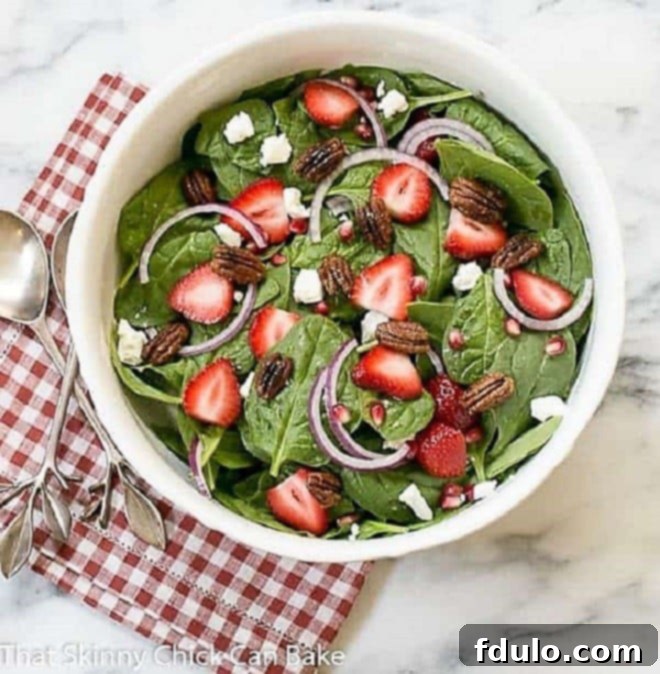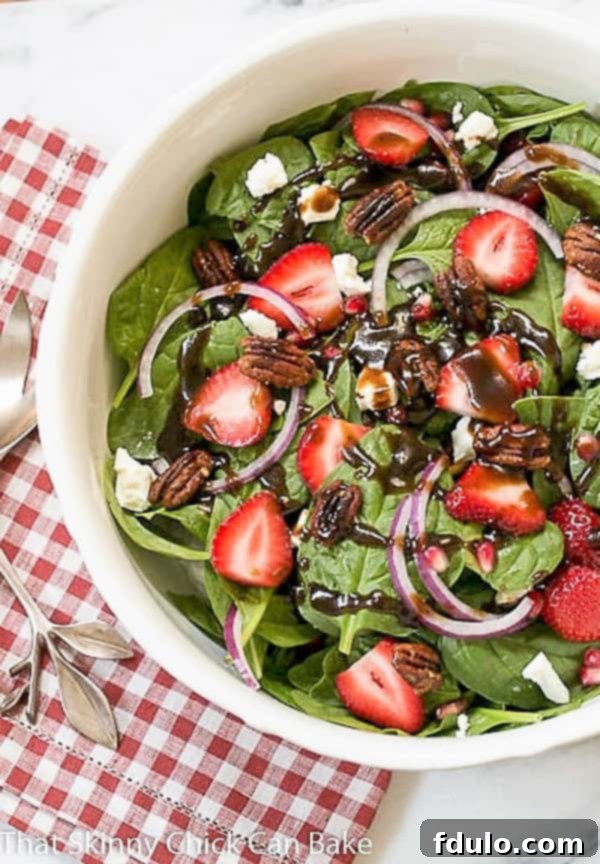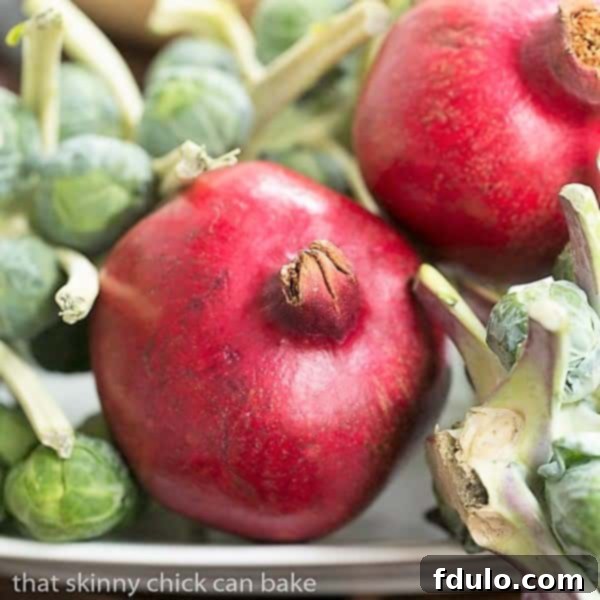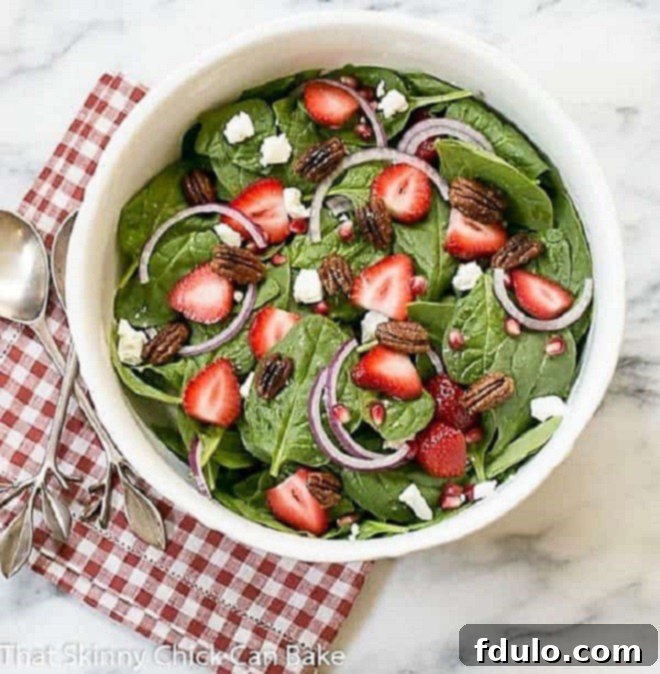Indulge in a symphony of flavors and textures with this vibrant Spinach, Strawberry, Pomegranate, Feta Salad. Every bite promises a delightful experience, perfectly complemented by my ultimate go-to dressing: a classic and irresistible Balsamic Vinaigrette Recipe!
While a simple lettuce and tomato salad might satisfy some, I believe a truly memorable salad should be an adventure for your palate. This recipe elevates the humble salad to a culinary masterpiece, featuring a delightful medley of fresh fruits, crunchy nuts, savory cheese, and, of course, a homemade vinaigrette that ties it all together.

Why This Spinach, Strawberry, Pomegranate, Feta Salad Is an Absolute Must-Try
This isn’t just another salad; it’s a celebration of fresh, wholesome ingredients that come together to create a dish that’s both visually stunning and incredibly delicious. Here’s why this particular combination deserves a spot on your table:
- Embrace the Pomegranate: Often, those beautiful pomegranates at the market catch our eye, but we’re unsure how to incorporate them into our meals. This salad offers an exquisite solution, showcasing the vibrant, jewel-like arils in a way that truly shines. Their sweet-tart burst is unparalleled.
- The Unforgettable Balsamic Vinaigrette: This homemade balsamic vinaigrette is more than just a dressing; it’s a game-changer. Its rich, tangy, and slightly sweet profile elevates every ingredient, and you’ll find yourself reaching for this versatile recipe to dress countless other salads. Its balanced flavor effortlessly complements a wide array of greens and toppings.
- A Symphony of Flavors and Textures: Prepare your taste buds for an exciting journey! This salad masterfully combines sweet strawberries, tangy pomegranate arils, creamy feta, and the fresh bite of spinach, all enhanced by the satisfying crunch of pecans. It’s a harmonious blend of sweet, tart, creamy, and sharp notes that will captivate even the most discerning palates.
- Visually Appealing & Perfectly Versatile: The stunning contrast of the ruby-red strawberries and pomegranate arils against the lush green spinach leaves is truly a feast for the eyes. Add in the golden pecans and snowy feta, and you have a dish that looks as good as it tastes. It’s elegant enough for dinner parties and special occasions, yet simple enough for a weeknight family dinner or a refreshing lunch. Plus, it’s packed with nutrients, making it a wholesome choice for any meal.
Unpacking the Star Ingredients for Your Salad
Creating an exceptional salad starts with selecting the best ingredients. Here’s a closer look at what you’ll need and some tips for choosing and preparing them:
- Kitchen Staples: Ensure you have basic pantry items like sugar, kosher salt, and freshly ground black pepper to perfectly season both your sugared pecans and the vinaigrette.
- Pecan Halves: These add a crucial crunch and a touch of sweet, buttery flavor. Our recipe includes instructions for making sugared pecans, which elevates their taste and texture, creating a delightful contrast against the other fresh ingredients. For an alternative, you could lightly toast them.
- Baby Spinach: Opt for baby spinach over mature leaves, as it is much more tender and less bitter, providing a delicate base for the salad. Purchasing it pre-washed and dried in a package saves valuable prep time and ensures convenience. Spinach is also a powerhouse of vitamins and minerals, adding a healthy boost.
- Red Onion: Thinly sliced red onion provides a sharp, zesty kick that cuts through the sweetness of the fruit and richness of the feta. If you find raw onion too potent, simply soak the slices in a bowl of cold water for 10-15 minutes before adding them to the salad; this method significantly reduces their sharpness.
- Fresh Strawberries: Seek out strawberries that are deeply red, fragrant, and free of white or green spots around the stem, which indicates ripeness. The leaves should appear fresh and green, and the berries themselves should be firm without any soft spots or signs of mold. Strawberries add a vibrant sweetness and are rich in Vitamin C and antioxidants.
- Feta Cheese: For the best texture and authentic flavor, I highly recommend buying a block of feta cheese and crumbling it yourself just before serving. Pre-crumbled feta often contains anti-caking agents and can be drier, lacking the creamy, salty tang of fresh block feta. Its briny notes perfectly complement the sweet fruit.
- Small Pomegranate: This fruit is the “jewel” of the salad, adding a beautiful color and a unique burst of sweet-tart juice. While you can often find pre-packaged pomegranate arils (seeds) in the refrigerated produce section, especially when in season, deseeding a fresh pomegranate is also quite simple. Refer to our frequently asked questions section for detailed instructions on how to easily extract the arils.
- Balsamic Vinegar: The quality of your balsamic vinegar is paramount for the vinaigrette. Invest in a good-quality, aged balsamic vinegar. A truly aged balsamic will be thicker, sweeter, and more complex, contributing a depth of flavor that cannot be replicated with cheaper alternatives.
- Dijon Mustard: A key ingredient for both flavor and emulsification in the dressing. My preferred brand is Grey Poupon for its consistent quality and balanced piquancy. It adds a subtle kick and helps bind the oil and vinegar together.
- Fresh Garlic Clove: Minced fresh garlic infuses the vinaigrette with a pungent, aromatic warmth. Using a garlic press is my preferred method for achieving a finely minced texture quickly and easily.
- Extra Virgin Olive Oil: For salad dressings, extra virgin olive oil is essential. Its fruity, robust flavor enhances the overall taste of the vinaigrette. California Olive Ranch is a reliable brand known for its high-quality extra virgin olive oil. Avoid using regular olive oil for dressings, as its flavor profile is not as vibrant.

Crafting the Perfect Homemade Balsamic Vinaigrette
A truly great salad is often defined by its dressing, and this balsamic vinaigrette is no exception. Making your own dressing from scratch is incredibly simple and yields a far superior result to store-bought options. I prefer to mix most of my salad dressings in a Pyrex measuring cup. Its convenient spout makes pouring into a storage jar effortless, and the side markings assist with precise measurements.
- The Foundation: Begin by pouring your chosen vinegar into your bowl or measuring cup. This is the base. Next, whisk in all your seasonings, such as salt and pepper, along with the Dijon mustard and minced garlic. Combine these thoroughly before introducing the oil.
- PRO-Tip: The Importance of Quality Balsamic: This step is absolutely crucial for an outstanding vinaigrette. Always use a good quality, aged balsamic vinegar. A premium balsamic should possess a natural sweetness and a slightly syrupy consistency, indicative of its aging process and concentrated flavor. While you can use other types of vinegar, you may need to compensate for the lack of sweetness by adding a small amount of honey or sugar to achieve a balanced flavor profile.
- Achieving Emulsification: Once your vinegar, seasonings, mustard, and garlic are well combined, it’s time to add the olive oil. Slowly drizzle in the extra virgin olive oil in a thin, steady stream while continuously whisking. This gradual addition and constant agitation allow the dressing to “emulsify” – meaning the oil and vinegar molecules are evenly dispersed, creating a thicker, homogenous mixture that won’t easily separate.
- PRO-Tip: Selecting Your Olive Oil: For cooking, regular olive oil is perfectly acceptable, but for salad dressings, extra virgin olive oil is the gold standard. Its unrefined nature retains its full, robust, and fruity flavor, which is vital for a fresh, vibrant dressing.
- PRO-Tip: The Magic of Dijon Mustard: Dijon mustard isn’t just for flavor; it plays a critical role in the vinaigrette’s texture. It adds a delightful piquancy that brightens the taste, but more importantly, it acts as an emulsifying agent. The compounds in Dijon mustard help stabilize the emulsion, preventing the oil and vinegar from separating too quickly. If you’re hesitant about mustard, start with just a teaspoon, but know that it’s key to achieving that perfect, creamy consistency.
So, grab your whisk, ensure you have a top-notch balsamic vinegar – I swear by an 18-year aged version from my local spice shop – and prepare to make a vinaigrette that will elevate any salad you serve!

Beyond the Salad: Versatile Uses for Pomegranates
Pomegranates are not only delicious but also incredibly versatile, offering a burst of flavor and striking color to a multitude of dishes. Don’t limit these ruby-red gems to just this salad; explore their full potential:
- Elegant Garnishes and Fruit Platters: Besides their starring role in salads, cracked-open pomegranates make an exquisite presentation on a winter fruit tray. Pair their rosy arils with other seasonal fruits like berries, pineapple, and kiwi for a visually stunning display. The gem-like arils spilling from the shell create an instant wow factor. They also look absolutely lovely on a cheese tray, providing a tart counterpoint to rich cheeses, especially when paired with crackers, nuts, and slices of crisp pear or apple.
- Vibrant Beverages: Pomegranate arils and juice can transform any drink into a festive concoction. Use them as a stunning garnish for cocktails like a Pomegranate Cosmo or a Pomegranate Champagne Cocktail. You can also muddle them into mocktails, add them to sparkling water for a refreshing infused drink, or blend them into smoothies for an antioxidant boost.
- Breakfast and Snack Enhancements: Elevate your morning routine by sprinkling pomegranate arils into your breakfast yogurt, over oatmeal, or on top of avocado toast for an unexpected pop of flavor and texture. Their tart sweetness brightens up any breakfast dish and adds a healthy dose of fiber and vitamins.
- Savory Dish Accents: Pomegranates aren’t just for sweet dishes. Their tartness makes them a fantastic garnish for grilled or roasted meats, such as chicken, lamb, or pork. The vibrant red arils provide a beautiful visual contrast and a refreshing burst that complements savory flavors. Consider tossing them into roasted vegetable dishes, like roasted Brussels sprouts or carrots, for an added layer of complexity and visual appeal.
Your Questions Answered: Pomegranate FAQs
Determining a pomegranate’s ripeness involves a few key indicators. First, observe its color; ripe pomegranates can range from a deep red to a pinkish-yellow blush. Avoid any with green patches, as this indicates it was picked too early and will not fully ripen. A ripe pomegranate will feel dense and heavy for its size, suggesting a juicy interior. While not perfectly spherical, it should have a slightly squarish shape with flattened sides. Gently tap it; a ripe pomegranate will often produce a metallic, hollow sound. Refer to the photos in this article for visual cues!
Absolutely! The edible parts of a pomegranate are indeed the seeds, commonly known as arils, and the juice surrounding them. Each tiny seed is encased in a plump, sweet, and vibrantly red pulp that provides a delightful burst of flavor and a slight crunch. These arils are packed with antioxidants, fiber, and vitamins, making them a healthy addition to your diet.
There are a couple of popular and effective methods to extract the arils without creating a mess.
Method 1: The Water Method
- First, carefully slice off the crown (stem end) of the pomegranate.
- Score the pomegranate deeply from the stem end down to the bottom, following the natural section divisions if visible. Aim for 4-6 cuts.
- Submerge the scored pomegranate in a bowl of cold water.
- While submerged, gently pull open the sections. The arils will easily release from the white membrane and sink to the bottom of the bowl, while the pith floats. This method prevents the juice from staining your hands or clothing.
- Skim off the floating pith and drain the arils using a colander.
Method 2: The Spoon Tapping Method
- Again, remove the stem end and make shallow cuts around the circumference, dividing the pomegranate into halves or quarters.
- Hold one section of the pomegranate cut-side down over a bowl.
- Using the back of a heavy spoon, firmly tap the exterior of the pomegranate. The arils will begin to fall out into the bowl. Be persistent, as it might take a few taps to get them all out.
Choose the method that feels most comfortable and efficient for you!
In the United States, pomegranates are typically in season from mid-September through early January. This makes them a wonderful addition to fall and winter recipes, perfect for holiday gatherings or simply adding a festive touch to your everyday meals. While the peak season offers the freshest and most abundant supply, you can often find pomegranate arils available pre-packaged in the refrigerated section of many grocery stores outside of this window.
Yes, several components of this salad can be prepared in advance to save time. You can make the balsamic vinaigrette and store it in an airtight container in the refrigerator for up to a week. The sugared pecans can also be made a day or two ahead and stored at room temperature in an airtight container. Pomegranate arils can be extracted and kept in the fridge for 3-4 days. However, for the freshest and best texture, assemble the salad just before serving and toss with the vinaigrette right before it hits the table to prevent the spinach from wilting.
Explore More Delicious Recipes
If you loved this vibrant salad and its incredible vinaigrette, you’re in for a treat! Here are more fantastic recipes to explore, from creamy dressings to satisfying main dishes:
- Blue Cheese Salad Dressing
- Honey French Salad Dressing
- Chicken Feta Casserole
- Best Cobb Salad Recipe
- Endive Cups with Blue Cheese and Raspberries
- Discover more of the Best Salad Recipes
Stay in touch through social media @ Instagram, Facebook, and Pinterest. Don’t forget to tag me when you try one of my recipes! And if you love the results, please give it a 5-star rating in the recipe card.

Spinach, Strawberry, Pomegranate, Feta Salad Recipe
10 minutes
5 minutes
15 minutes
4 servings
A lovely salad dressed with the most fabulous balsamic vinaigrette.
Ingredients
- ½ cup sugared pecans (see instructions below)
- 1 tablespoon sugar (for pecans)
- 5 ounces baby spinach
- ½ small red onion, thinly sliced
- 8 ounces sliced strawberries
- ½ cup crumbled Feta cheese
- Seeds (arils) from one small pomegranate
For the Balsamic Vinaigrette:
- 3 tablespoons balsamic vinegar, premium, aged
- 2 teaspoons Dijon mustard
- 1 garlic clove, minced
- ½ cup extra virgin olive oil
- ½ teaspoon kosher salt
- A pinch of freshly ground black pepper
Instructions
- To Make Sugared Pecans: In a nonstick saute pan, combine the pecan halves with 1 tablespoon of sugar. Cook over medium heat, stirring frequently, until the sugar melts and evenly coats the pecans.
- Once coated, remove the sugared pecans from the pan and spread them onto non-stick foil or parchment paper to cool completely. They will crisp up as they cool.
- To Make the Vinaigrette: In a medium bowl or Pyrex measuring cup, whisk together the balsamic vinegar, Dijon mustard, and minced garlic until well combined. Gradually add the extra virgin olive oil in a slow, steady stream while continuously whisking until the mixture is fully emulsified and thickened. Season with kosher salt and freshly ground black pepper to taste.
- To Assemble the Salad: Place the baby spinach in a large serving bowl. Arrange the thinly sliced red onion, sliced strawberries, crumbled Feta cheese, pomegranate arils, and the cooled sugared pecans on top of the spinach. Just before serving, drizzle the homemade balsamic vinaigrette over the salad and gently toss to combine. Serve immediately.
Notes
For the most flavorful dressing, always use the best quality balsamic vinegar you can find. An 18-year aged balsamic vinegar is highly recommended for its richness and sweetness.
If you prefer a milder onion flavor, soak the thinly sliced red onions in cold water for about 10-15 minutes before adding them to the salad. This helps to reduce their sharpness.
Nutrition Information:
Yield:
4
Serving Size:
1
Amount Per Serving:
Calories: 456Total Fat: 37gSaturated Fat: 7gTrans Fat: 0gUnsaturated Fat: 28gCholesterol: 17mgSodium: 572mgCarbohydrates: 30gFiber: 6gSugar: 22gProtein: 6g
HOW MUCH DID YOU LOVE THIS RECIPE?
Please leave a comment on the blog or share a photo on Pinterest
